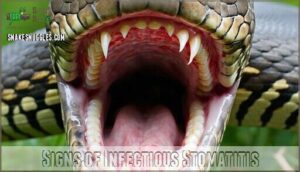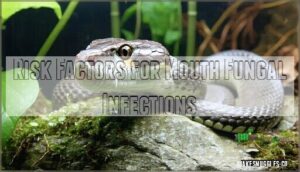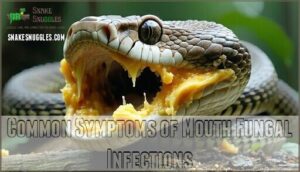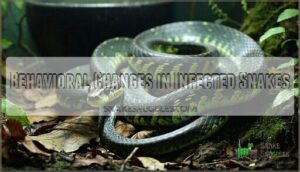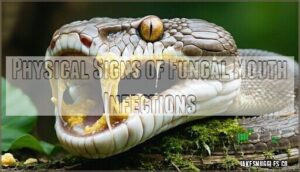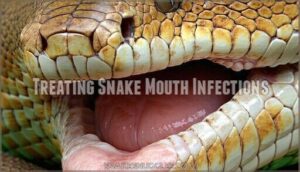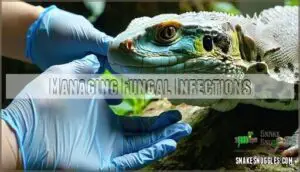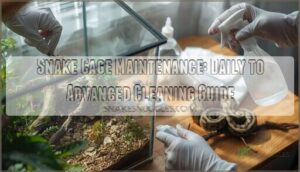This site is supported by our readers. We may earn a commission, at no cost to you, if you purchase through links.
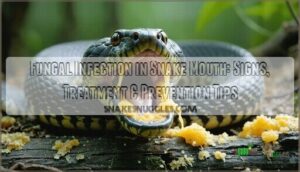
You’ll notice thick, cheesy discharge, swollen gums, difficulty eating, and foul odors emanating from their mouth.
Poor husbandry conditions like excessive humidity, inadequate temperatures, or dirty enclosures create perfect breeding grounds for these opportunistic pathogens.
Stress from overcrowding or handling also weakens your snake’s immune system.
Without prompt veterinary intervention, the infection spreads rapidly, potentially causing severe tissue damage or death.
Treatment typically involves antifungal medications, improved environmental conditions, and supportive care.
The key lies in recognizing early warning signs and understanding prevention strategies.
It is crucial to address these issues promptly to ensure the health and well-being of your snake, as prompt veterinary intervention is vital in such cases.
Table Of Contents
- Key Takeaways
- Snake Mouth Fungal Infection
- Recognizing Mouth Infections
- Fungal Disease Symptoms
- Treating Snake Mouth Infections
- Managing Fungal Infections
- Frequently Asked Questions (FAQs)
- How do you treat a snake’s mouth infection?
- How to treat fungal infections in snakes?
- What does a fungal infection look like in the mouth?
- What does snake fungal disease look like?
- How do you treat a snake fungal infection?
- How do you treat a snake mouth infection?
- What kills a fungal infection in the mouth?
- How does diet influence snake fungal infections?
- Can fungal infections transmit between different snake species?
- What are early signs of snake stress?
- Conclusion
Key Takeaways
- Watch for early warning signs – You’ll spot thick discharge, swollen gums, difficulty eating, and foul odors that signal your snake needs immediate veterinary attention before the infection spreads.
- Control your snake’s environment – Keep humidity between 50-60%, maintain proper temperatures, clean the enclosure weekly, and ensure good ventilation to prevent fungal spores from thriving.
- Get professional treatment fast – Don’t attempt home remedies; your vet will prescribe antifungal medications like itraconazole and may need to surgically remove infected tissue for severe cases.
- Prevent reinfection through proper care – You’ll need to disinfect all equipment, quarantine new snakes for 30-90 days, maintain optimal nutrition, and monitor your snake’s behavior regularly to catch problems early.
Snake Mouth Fungal Infection
Snake mouth fungal infections can seriously threaten your pet’s health if left untreated, causing painful lesions and difficulty eating.
You’ll need to recognize the early warning signs and act quickly to prevent complications that could become life-threatening.
Causes of Fungal Infections
Behind your snake’s mouth fungus lies a perfect storm of Environmental Factors and Weakened Immunity.
**Fungal spores lurk in every dirty enclosure, waiting for your snake’s defenses to drop.
Poor Hygiene in enclosures creates breeding grounds where opportunistic fungi like Ophidiomyces ophidiicola thrive.
Stress, malnutrition, and temperature fluctuations compromise your snake’s defenses, while Wound Contamination from feeding injuries provides entry points.
Gram-negative bacteria can also contribute to the issue.
This toxic combination triggers Fungal Overgrowth, transforming harmless spores into aggressive pathogens causing snake stomatitis and devastating snake oral infections.
Symptoms of Mouth Fungal Disease
You’ll notice snake mouth rot symptoms appearing as telltale warning signs.
Watch for these key indicators:
- Lesion Appearance – Red, swollen areas around the mouth
- Breathing Difficulty – Labored or open-mouth breathing patterns
- Eating Habits – Refusing food or struggling to swallow
- Weight Loss – Gradual decline in body condition
- Saliva Changes – Thick, discolored discharge from mouth
Snake stomatitis and snake oral infection create visible mouth fungus that you can’t ignore.
Diagnosis of Snake Mouth Infections
When your snake shows oral lesions, you’ll need professional veterinary diagnosis to confirm fungal infection.
Your vet will use multiple diagnostic methods to identify the specific pathogen causing snake mouth rot. Notably, compromised oral mucosa can be a predisposing factor.
| Diagnostic Method | Process | Purpose |
|---|---|---|
| Oral Swabs | Sample collection from lesions | Detect fungal DNA/organisms |
| Culture Analysis | Laboratory growth of pathogens | Identify specific fungal species |
| Microscopic Exams | Tissue examination with special stains | Reveal fungal structures in tissue |
| Biopsy Options | Tissue sample removal and analysis | Confirm invasive stomatitis in snakes |
| Imaging Techniques | X-rays or CT scans if needed | Assess bone involvement depth |
Your veterinarian will combine clinical signs with laboratory results for accurate snake oral health assessment and proper snake vet care recommendations.
Treatment Options for Fungal Infections
When treating snake stomatitis, you’ll need antifungal medications as your first line of defense.
Your vet will prescribe topical treatments or systemic antifungal treatments depending on severity.
Surgical intervention removes necrotic tissue, while supportive care includes proper heating and nutrition.
Preventative measures and holistic approaches guarantee complete recovery from snake mouth fungus infections.
Recognizing Mouth Infections
You’ll recognize mouth infections in your snake by watching for early warning signs that appear before the condition becomes severe.
Look for white or yellowish patches, excessive saliva, difficulty eating, and swollen gums around the mouth area.
These signs, including excessive saliva, are crucial for identifying mouth infections early on, allowing for timely intervention.
Signs of Infectious Stomatitis
Infectious stomatitis creeps up on snakes when their immune systems can’t fight back effectively.
During your oral examination, watch for these critical early symptoms:
- Swelling signs around the mouth and gums that weren’t there before
- Lesion appearance showing as white, yellow, or gray patches inside the mouth
- Appetite loss when your snake refuses food for several feeding cycles
Snake mouth fungus often starts small but spreads quickly throughout the oral cavity.
Snake mouth infection causes visible inflammation, making the gums appear red and puffy.
Snake fungal infection symptoms worsen without prompt intervention, so don’t wait to seek veterinary care when treating snake stomatitis becomes necessary.
Risk Factors for Mouth Fungal Infections
Several factors increase your snake’s risk of developing mouth fungal infections.
High humidity levels above 70% create perfect breeding grounds for fungi, while trauma from rough handling or cage fixtures opens pathways for infection.
Weakened immunity from illness makes snakes vulnerable, and poor hygiene in enclosures allows pathogens to flourish.
| Risk Factor | Impact Level | Common Causes |
|---|---|---|
| Humidity Levels | High | Poor ventilation, water bowl placement |
| Trauma/Injury | Medium | Rough handling, sharp cage decorations |
| Weakened Immunity | High | Illness, malnutrition, age |
| Poor Hygiene | High | Dirty substrate, infrequent cleaning |
| Stress Factors | Medium | Temperature fluctuations, overcrowding |
Prevention of Mouth Fungal Diseases
Prevention starts with proper hygiene practices and consistent snake mouth care routines.
You’ll need to maintain ideal humidity control between 50-60% and implement strict quarantine protocols for new reptiles.
Diet optimization with calcium-rich foods supports immune function, while regular probiotic use promotes healthy oral bacteria.
Clean enclosures weekly, monitor temperatures closely, and address snake health issues immediately to prevent reptile stomatitis and treating mouth rot situations.
Early detection may require bacterial cultures for accurate diagnosis, which is crucial for early detection and treating mouth rot situations.
Fungal Disease Symptoms
When you notice your snake struggling to eat or refusing food entirely, fungal mouth infections might be the culprit affecting their appetite and behavior.
These infections create visible changes in your snake’s mouth along with shifts in their normal eating patterns and activity levels, which can be a clear indication of a problem, often related to appetite.
Common Symptoms of Mouth Fungal Infections
When you spot fungal infection snakes, you’ll notice distinct oral discharge that appears thick, yellowish, or cheese-like around their mouth.
This messy situation often comes with swollen gums that look puffy and inflamed, making eating uncomfortable.
- Lesion appearance – White, yellow, or grayish patches inside the mouth
- Breathing difficulty – Open-mouth breathing or wheezing sounds during respiration
- Appetite loss – Refusing food for extended periods despite normal feeding schedule
- Snake disease symptoms – Combined oral and respiratory signs requiring immediate snake mouth care attention
Behavioral Changes in Infected Snakes
Appetite changes often signal the first red flag when fungal infection strikes your snake.
You’ll notice lethargy signs as your pet becomes less active and seeks social isolation from handling.
Regurgitation frequency increases while defensive behavior escalates during routine care.
These snake disease symptoms indicate reptile mouth rot may be developing.
Infected snakes typically refuse food completely and spend excessive time hiding in their enclosures, avoiding normal basking behaviors that healthy reptiles display regularly.
Physical Signs of Fungal Mouth Infections
Examining your snake’s mouth carefully reveals telltale signs of fungal infection symptoms that demand immediate attention.
Reptile mouth rot manifests through distinct physical markers that you can’t ignore.
- Lesion Appearance: White, yellow, or grayish patches along gums and mouth tissues
- Swelling Location: Pronounced inflammation around jaw joints and oral cavity
- Discharge Characteristics: Thick, cottage cheese-like secretions with foul odor
- Breathing Difficulty: Labored respiration due to blocked nasal passages
- Eating Habits: Reluctance to feed or complete refusal of food
These fungal symptoms progress rapidly without treatment.
Treating Snake Mouth Infections
When your snake develops a mouth fungal infection, you’ll need to act quickly with the right treatment approach.
Effective treatment combines antifungal medications, proper wound care, and supportive therapy to help your snake recover completely.
Antifungal Medications for Snakes
Your vet will prescribe specific antifungal medications to combat snake fungal disease effectively. Itraconazole remains the gold standard at 10mg/kg daily, while voriconazole offers another option at similar dosing.
Itraconazole is the gold standard for treating snake fungal infections, helping your pet recover faster and more comfortably.
Terbinafine works well for mouth lesions through nebulization or oral administration. Drug dosage requires careful monitoring since medication side-effects like liver toxicity can occur.
As the U.S. Fish & Wildlife Service notes, snake fungal disease is caused by the fungus Ophidiomyces ophiodiicola. Resistance development remains uncommon, but alternative therapies may become necessary for stubborn infections.
Surgical Treatment for Mouth Lesions
When antifungal medications aren’t enough, surgical intervention becomes necessary.
Severe fungal infection cases require aggressive debridement techniques to remove infected tissue and restore your snake’s oral health.
Here’s what surgical fungal treatment involves:
- Lesion Excision – Complete removal of infected mouth tissue under anesthesia
- Debridement Techniques – Thorough cleaning of necrotic material using sterile instruments
- Grafting Options – Tissue reconstruction when extensive removal creates defects
- Post-Op Care – Daily antiseptic irrigation and wound monitoring for healing
Pain management protocols guarantee your snake’s comfort throughout recovery.
This snake fungal treatment approach addresses cases where oral lesions won’t respond to standard fungal infection treatment alone.
Post-operative care often requires specialized debridement supplies to guarantee proper healing.
Thermal and Nutritional Support
Beyond surgical intervention, your snake’s recovery depends heavily on proper thermal and nutritional support.
Maintaining ideal heating gradients between 78-88°F accelerates healing and boosts immune function during fungal treatment. You’ll need to monitor enclosure humidity carefully, keeping it around 50-60% to prevent further complications.
| Support Category | Treatment Phase | Recovery Phase |
|---|---|---|
| Temperature | 82-85°F basking spot | 80-83°F maintenance |
| Nutrition | Appetite stimulants, small prey | Dietary supplements, normal feeding |
| Hydration | Assisted water intake | Fresh water access daily |
| Environment | Reduced humidity (45-50%) | Stable humidity (55-60%) |
Proper hydration methods become your best friend when fighting fungal diseases in your snake’s mouth.
Managing Fungal Infections
Managing fungal infections in your snake’s mouth requires a thorough approach that combines proper hygiene, environmental controls, and careful monitoring.
You’ll need to address multiple factors simultaneously, including cage sanitation, nutrition optimization, temperature regulation, and quarantine protocols to effectively prevent reinfection and support your snake’s recovery.
The goal is to effectively prevent reinfection and support your snake’s recovery by addressing these factors.
Proper Cage Cleaning and Hygiene
Clean cages prevent fungal infection by eliminating spores that thrive in dirty environments.
Replace substrate weekly, removing all waste immediately to stop fungus growth. Disinfect surfaces with reptile-safe cleaners monthly.
Change water bowls every few days for proper water sanitation. Monitor humidity levels between 50-60% using reliable gauges.
Use a specialized cage disinfectant for ideal hygiene. Poor cage disinfection creates breeding grounds where mouth and skin infections flourish, making consistent environmental factors management your snake’s best defense, through proper water sanitation.
Nutrition and Dietary Considerations
Proper nutrition strengthens your snake’s immune system against fungal infections.
Nutritional deficiencies weaken resistance, making mouth fungus more likely.
Quality prey maintains gut microbiome balance, while poor-quality food disrupts it.
Fresh water prevents dehydration, which compromises immunity.
Consider supplementation needs if your snake shows deficiency signs.
Remember, a well-fed snake fights fungal infection risk factors better than a malnourished one, and proper care can help prevent issues related to fungal infections.
Environmental Factors and Temperature Control
Maintaining proper Humidity Levels between 50-60% prevents fungal infection growth while excessive moisture creates ideal conditions for fungus to thrive.
Your snake’s enclosure needs adequate Ventilation Quality with proper air circulation to reduce stagnant, humid pockets. Proper airflow is key, and ventilation products are available to help.
Choose appropriate Substrate Choice that doesn’t retain excess moisture near the mouth area. Establish a clear Thermal Gradient with temperatures ranging from cool to warm zones, ensuring your Basking Spot reaches ideal temperatures for environmental survival and immune function support.
Quarantine and Isolation Procedures
Every snake owner needs effective quarantine duration and isolation setup protocols to prevent fungal infection transmission throughout their collection.
Isolate new arrivals for 30-90 days using separate enclosures, tools, and strict hygiene protocols while monitoring symptoms daily for early detection.
To guarantee thorough protection, consider the importance of disease prevention.
- Dedicated isolation rooms with HEPA-filtered ventilation systems reduce airborne fungal spores
- Weekly fungal cultures or PCR testing confirm absence of pathogenic organisms before release
- 1:10 bleach solution disinfection with 15-minute contact time eliminates common snake fungi
- Daily visual inspections for oral swelling, weight loss, or behavioral changes catch infections early
- Complete tool separation prevents cross-contamination between quarantined and general population snakes
Frequently Asked Questions (FAQs)
How do you treat a snake’s mouth infection?
When spotting serious injury signs, you’ll need immediate veterinary care. Treatment requires injectable antibiotics, mouth cleaning, and antibiotic rinsing. Expect weeks of oral flushing and antibiotic therapy for complete recovery.
How to treat fungal infections in snakes?
You’ll need antifungal medications from a reptile veterinarian.
Apply topical treatments like betadine or prescribed antifungal creams.
Improve habitat conditions by reducing humidity and increasing temperatures.
Clean the enclosure thoroughly and maintain proper hygiene.
What does a fungal infection look like in the mouth?
Approximately 60% of respiratory infections in reptiles involve fungal pathogens.
You’ll notice white, yellow, or grayish patches covering the mouth’s tissues, often accompanied by thick, cottage cheese-like discharge and visible swelling around affected areas.
What does snake fungal disease look like?
You’ll notice snake fungal disease through opaque eyes and hard, crusty scales, alongside facial swelling, nodules, and ulcerations that can prevent proper feeding abilities.
How do you treat a snake fungal infection?
Seek immediate veterinary care for proper diagnosis and treatment.
Vets may prescribe systemic antifungals like itraconazole or voriconazole, along with supportive thermal and nutritional care.
Don’t attempt home remedies—professional treatment gives your snake the best recovery chance.
How do you treat a snake mouth infection?
When your snake’s mouth becomes a battlefield, you’ll need to act quickly. Consult a reptile veterinarian immediately for proper diagnosis and aggressive antibiotic treatment to prevent life-threatening complications.
What kills a fungal infection in the mouth?
Antifungal medications like nystatin, fluconazole, or clotrimazole effectively eliminate oral fungal infections. You’ll typically use topical treatments, oral medications, or antifungal rinses depending on severity and your doctor’s recommendation.
How does diet influence snake fungal infections?
Can your diet strengthen immunity against these infections?
Your nutritional status directly affects immune function, and when you’re weakened, fungal infections can become severe.
Proper nutrition supports your body’s ability to fight off pathogens naturally.
Can fungal infections transmit between different snake species?
Yes, fungal infections can hop between different snake species, especially in shared enclosures or when equipment isn’t cleaned well.
You’ll want to separate sick snakes, sanitize habitats, and wash your hands to prevent cross-species spread.
What are early signs of snake stress?
When you’re between a rock and a hard place with your snake’s health, watch for decreased appetite, excessive hiding, irregular shedding, aggression changes, and unusual positioning.
These stress signals indicate your pet needs environmental adjustments or veterinary attention.
Conclusion
Successfully preventing a fungal infection in snake mouth requires vigilance like a sentinel guarding against unseen threats.
You’ve learned that maintaining proper humidity levels, regular enclosure cleaning, and monitoring your snake’s behavior can prevent most mouth infections.
When you spot early warning signs like discharge or swelling, don’t hesitate to contact your veterinarian immediately.
Remember, your snake’s health depends on consistent environmental management and prompt medical attention when needed.
- https://www.cwhc-rcsf.ca/docs/fact_sheets/SFD_FactSheet.pdf
- https://cwhl.vet.cornell.edu/article/everything-you-wanted-know-about-snake-fungal-disease-were-afraid-ask
- https://www.merckvetmanual.com/exotic-and-laboratory-animals/reptiles/mycotic-diseases-of-reptiles
- https://pmc.ncbi.nlm.nih.gov/articles/PMC10053826/
- https://www.thebhs.org/publications/the-herpetological-bulletin/issue-number-52-summer-1995/2585-hb052-08/file

